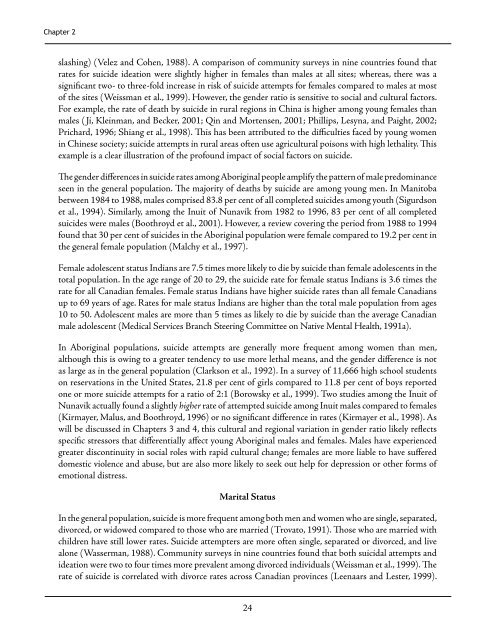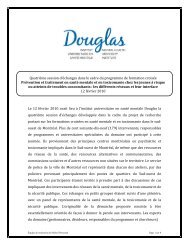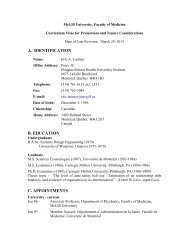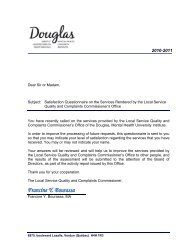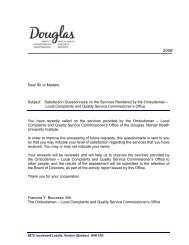Suicide Among Aboriginal People in Canada - Institut universitaire ...
Suicide Among Aboriginal People in Canada - Institut universitaire ...
Suicide Among Aboriginal People in Canada - Institut universitaire ...
You also want an ePaper? Increase the reach of your titles
YUMPU automatically turns print PDFs into web optimized ePapers that Google loves.
Chapter 2slash<strong>in</strong>g) (Velez and Cohen, 1988). A comparison of community surveys <strong>in</strong> n<strong>in</strong>e countries found thatrates for suicide ideation were slightly higher <strong>in</strong> females than males at all sites; whereas, there was asignificant two- to three-fold <strong>in</strong>crease <strong>in</strong> risk of suicide attempts for females compared to males at mostof the sites (Weissman et al., 1999). However, the gender ratio is sensitive to social and cultural factors.For example, the rate of death by suicide <strong>in</strong> rural regions <strong>in</strong> Ch<strong>in</strong>a is higher among young females thanmales ( Ji, Kle<strong>in</strong>man, and Becker, 2001; Q<strong>in</strong> and Mortensen, 2001; Phillips, Lesyna, and Paight, 2002;Prichard, 1996; Shiang et al., 1998). This has been attributed to the difficulties faced by young women<strong>in</strong> Ch<strong>in</strong>ese society; suicide attempts <strong>in</strong> rural areas often use agricultural poisons with high lethality. Thisexample is a clear illustration of the profound impact of social factors on suicide.The gender differences <strong>in</strong> suicide rates among <strong>Aborig<strong>in</strong>al</strong> people amplify the pattern of male predom<strong>in</strong>anceseen <strong>in</strong> the general population. The majority of deaths by suicide are among young men. In Manitobabetween 1984 to 1988, males comprised 83.8 per cent of all completed suicides among youth (Sigurdsonet al., 1994). Similarly, among the Inuit of Nunavik from 1982 to 1996, 83 per cent of all completedsuicides were males (Boothroyd et al., 2001). However, a review cover<strong>in</strong>g the period from 1988 to 1994found that 30 per cent of suicides <strong>in</strong> the <strong>Aborig<strong>in</strong>al</strong> population were female compared to 19.2 per cent <strong>in</strong>the general female population (Malchy et al., 1997).Female adolescent status Indians are 7.5 times more likely to die by suicide than female adolescents <strong>in</strong> thetotal population. In the age range of 20 to 29, the suicide rate for female status Indians is 3.6 times therate for all Canadian females. Female status Indians have higher suicide rates than all female Canadiansup to 69 years of age. Rates for male status Indians are higher than the total male population from ages10 to 50. Adolescent males are more than 5 times as likely to die by suicide than the average Canadianmale adolescent (Medical Services Branch Steer<strong>in</strong>g Committee on Native Mental Health, 1991a).In <strong>Aborig<strong>in</strong>al</strong> populations, suicide attempts are generally more frequent among women than men,although this is ow<strong>in</strong>g to a greater tendency to use more lethal means, and the gender difference is notas large as <strong>in</strong> the general population (Clarkson et al., 1992). In a survey of 11,666 high school studentson reservations <strong>in</strong> the United States, 21.8 per cent of girls compared to 11.8 per cent of boys reportedone or more suicide attempts for a ratio of 2:1 (Borowsky et al., 1999). Two studies among the Inuit ofNunavik actually found a slightly higher rate of attempted suicide among Inuit males compared to females(Kirmayer, Malus, and Boothroyd, 1996) or no significant difference <strong>in</strong> rates (Kirmayer et al., 1998). Aswill be discussed <strong>in</strong> Chapters 3 and 4, this cultural and regional variation <strong>in</strong> gender ratio likely reflectsspecific stressors that differentially affect young <strong>Aborig<strong>in</strong>al</strong> males and females. Males have experiencedgreater discont<strong>in</strong>uity <strong>in</strong> social roles with rapid cultural change; females are more liable to have suffereddomestic violence and abuse, but are also more likely to seek out help for depression or other forms ofemotional distress.Marital StatusIn the general population, suicide is more frequent among both men and women who are s<strong>in</strong>gle, separated,divorced, or widowed compared to those who are married (Trovato, 1991). Those who are married withchildren have still lower rates. <strong>Suicide</strong> attempters are more often s<strong>in</strong>gle, separated or divorced, and livealone (Wasserman, 1988). Community surveys <strong>in</strong> n<strong>in</strong>e countries found that both suicidal attempts andideation were two to four times more prevalent among divorced <strong>in</strong>dividuals (Weissman et al., 1999). Therate of suicide is correlated with divorce rates across Canadian prov<strong>in</strong>ces (Leenaars and Lester, 1999).24


